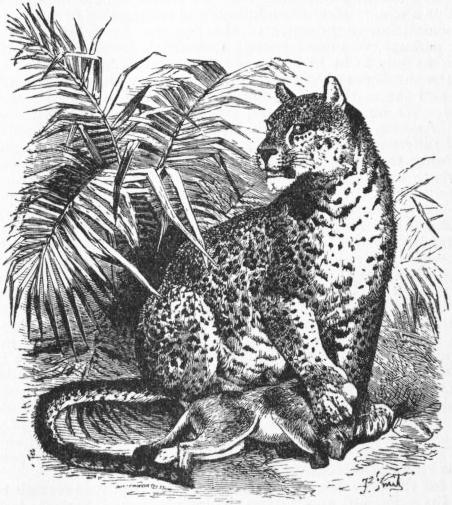Leopard,1 Pard or Panther (Felis pardus), the largest spotted true cat of the Old World, with the exception of the snow-leopard, which is, however, inferior in point of size to the largest leopard. (See Carnivora and Snow-Leopard.) Leopards, known in India as cheeta (chita), are characterized by the rosette-like form of the black spots on the greater part of the body, and the absence of a central spot from each rosette. Towards the head and on the limbs the spots tend to become solid, but there is great local variation in regard to their form and arrangement. In the Indian leopard, the true Felis pardus, the spots are large and rosette-like, and the same is the case with the long-haired Persian leopard (F. pardus tulliana). On the other hand the heavily built and thick-haired Manchurian F. p. villosa has more consolidated spots. African leopards, again, to one of which the name F. p. leopardus is applicable, show a decided tendency to a breaking-up of the spots; West African animals being much darker-coloured than those from the east side of the continent.
Both as regards structure and habits, the leopard may be reckoned as one of the more typical representatives of the genus Felis, belonging to that section in which the hyoid bone is loosely connected with the skull, owing to imperfect ossification of its anterior arch, and the pupil of the eye when contracted under the influence of light is circular, not linear as in the smaller cats.
The size of leopards varies greatly, the head and body usually measuring from 3½ to 4½ ft. in length, and the tail from 2½ to 3 ft., but some specimens exceed these limits, while the Somali leopard (F. p. nanopardus) falls considerably short of them. The ground-colour of the fur varies from a pale fawn to a rufous buff, graduating in the Indian race into pure white on the under-parts and inside of the limbs. Generally speaking, the spots on the under parts and limbs are simple and blacker than those on the other parts of the body. The bases of the ears behind are black, the tips buff. The upper side of the tail is buff, spotted with broken rings like the back, its under surface white with simple spots. The hair of the cubs is longer than that of the adults, its ground-colour less bright, and its spots less distinct. Perfectly black leopards, which in certain lights show the characteristic markings on the fur, are not uncommon, and are examples of melanism, occurring as individual variations, sometimes in one cub out of a litter of which the rest are normally coloured, and therefore not indicating a distinct race, much less a species. These are met with chiefly in southern Asia; melanism among African leopards taking the form of an excessive breaking-up of the spots, which finally show a tendency to coalesce.
 |
| The Leopard (Felis pardus). |
In habits the leopard resembles the other large cat-like animals, yielding to none in the ferocity of its disposition. It is exceedingly quick in its movements, but seizes its prey by waiting in ambush or stealthily approaching to within springing distance, when it suddenly rushes upon it and tears it to ground with its powerful claws and teeth. It preys upon almost any animal it can overcome, such as antelopes, deer, sheep, goats, monkeys, peafowl, and has a special liking for dogs. It not unfrequently attacks human beings in India, chiefly children and old women, but instances have been known of a leopard becoming a regular “man-eater.” When favourable opportunities occur, it often kills many more victims than it can devour at once, either to gratify its propensity for killing or for the sake of their fresh blood. It generally inhabits woody districts, and can climb trees with facility when hunted, but usually lives on or near the ground, among rocks, bushes and roots and low branches of large trees.
The geographical range of the leopard embraces practically all Africa, and Asia from Palestine to China and Manchuria, inclusive of Ceylon and the great Malay Islands as far as Java. Fossil bones and teeth, indistinguishable from those of existing leopards, have been found in cave-deposits of Pleistocene age in Spain, France, Germany and England.
1 The name (Late Lat. leopardus, Late Gr. λεόπαρδος) was given by the ancients to an animal supposed to have been a cross between a lion (Lat. leo, Gr. λὲων) and a pard (Gr. πάρδος, Pers. pars) or panther. Medieval heralds made no distinction in shape between a lion and a leopard, but marked the difference by drawing the leopard showing the full face (see Heraldry: § Beasts and Birds).


